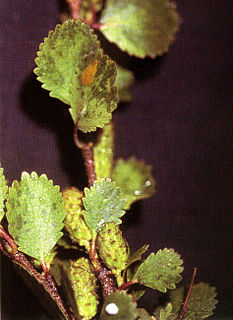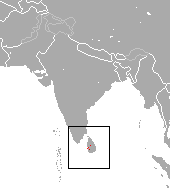
A birch is a thin-leaved deciduous hardwood tree of the genus Betula, in the family Betulaceae, which also includes alders, hazels, and hornbeams. It is closely related to the beech-oak family Fagaceae. The genus Betula contains 30 to 60 known taxa of which 11 are on the IUCN 2011 Red List of Threatened Species. They are a typically rather short-lived pioneer species widespread in the Northern Hemisphere, particularly in northern areas of temperate climates and in boreal climates.

Betula pendula, commonly known as silver birch, warty birch, European white birch, or East Asian white birch, is a species of tree in the family Betulaceae, native to Europe and parts of Asia, though in southern Europe, it is only found at higher altitudes. Its range extends into Siberia, China, and southwest Asia in the mountains of northern Turkey, the Caucasus, and northern Iran. It has been introduced into North America, where it is known as the European white birch, and is considered invasive in some states in the United States and parts of Canada. The tree can also be found in more temperate regions of Australia.

Betula pubescens, commonly known as downy birch and also as moor birch, white birch, European white birch or hairy birch, is a species of deciduous tree, native and abundant throughout northern Europe and northern Asia, growing farther north than any other broadleaf tree. It is closely related to, and often confused with, the silver birch, but grows in wetter places with heavier soils and poorer drainage; smaller trees can also be confused with the dwarf birch.

Betula nigra, the black birch, river birch or water birch, is a species of birch native to the Eastern United States from New Hampshire west to southern Minnesota, and south to northern Florida and west to Texas. It is one of the few heat-tolerant birches in a family of mostly cold-weather trees which do not thrive in USDA Zone 6 and up. B. nigra commonly occurs in floodplains and swamps.

Betula alleghaniensis, the yellow birch, golden birch, or swamp birch, is a large and important lumber species of birch native to North-eastern North America. Its vernacular names refer to the golden color of the tree's bark. The name Betula lutea was used expansively for this tree but has now been replaced.

Betula lenta is a species of birch native to eastern North America, from southern Maine west to southernmost Ontario, and south in the Appalachian Mountains to northern Georgia.

Betula nana, the dwarf birch, is a species of birch in the family Betulaceae, found mainly in the tundra of the Arctic region.

Abies forrestii is a species of conifer in the family Pinaceae, endemic to China. It is named after the Scottish botanist and plant-hunter George Forrest (1873–1932), who discovered it for western science in Yunnan province. Its common names include Forrest's fir.

The jungle shrew is a species of mammal in the family Soricidae endemic to Sri Lanka. Its natural habitat is subtropical or tropical dry forests. It is threatened by habitat loss.
Betula browicziana is a species of plant in the Betulaceae family. It is found in Georgia and Turkey.
Betula halophila is a species of plant in the Betulaceae family. It is endemic to China.
Betula recurvata is a species of plant in the Betulaceae family. It is endemic to Turkey.
Betula szaferi is a proposed species of plant in the Betulaceae family, but it is otherwise a local form of Betula pendula. It would have been endemic to Poland. No wild subpopulations are presently known, but there is a specimen planted in Kraków Botanical Garden.

Betula uber, Virginia round-leaf birch, is a rare species of tree in the birch family. One of the most endangered species of North American trees, it is endemic to Smyth County, in the U.S. state of Virginia. It is part of the temperate broadleaf and mixed forests biome.

The World's 25 Most Endangered Primates is a list of highly endangered primate species selected and published by the International Union for Conservation of Nature Species Survival Commission Primate Specialist Group, the International Primatological Society (IPS), and Conservation International (CI). The 2012–2014 list added the Bristol Conservation and Science Foundation (BCSF) to the list of publishers. The IUCN/SSC PSG worked with CI to start the list in 2000, but in 2002, during the 19th Congress of the International Primatological Society, primatologists reviewed and debated the list, resulting in the 2002–2004 revision and the endorsement of the IPS. The publication has since been a joint project between the three conservation organizations and has been revised every two years following the biannual Congress of the IPS. Starting with the 2004–2006 report, the title changed to "Primates in Peril: The World's 25 Most Endangered Primates". That same year, the list began to provide information about each species, including their conservation status and the threats they face in the wild. The species text is written in collaboration with experts from the field, with 60 people contributing to the 2006–2008 report and 85 people contributing to the 2008–2010 report. The 2004–2006 and 2006–2008 reports were published in the IUCN/SSC PSG journal Primate Conservation, while the 2008–2010 and 2010-2012 report were published as independent publications by all three contributing organizations.

The Tusheti National Park in eastern Georgia is one of the eight new protected areas approved by Parliament of Georgia on 22 April 2003.
Betula klokovii is a species of tree restricted to Ukraine. These trees grow on sandy hills in steppe grasses and dry chalkstone or in open woodlands. It is only found in two mountains: Strakhova and Maslyatyn, near Kremenets in the Ternopil region.

Tusheti Strict Nature Reserve is located in the Tusheti Mountainous region in the north-eastern part of Georgia. Visitors center is located in village lower Alvani, Akhmeta Municipality.














